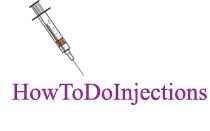You are using an out of date browser. It may not display this or other websites correctly.
You should upgrade or use an alternative browser.
You should upgrade or use an alternative browser.
Input on clomid plz
- Thread starter suparay
- Start date
suparay
Banned
- Joined
- Mar 15, 2009
- Messages
- 1,135
This is a cut & paste from Big A... "Also, you have a
choice between HCG every 4 weeks at 5000IU or Clomid
at 50mg EOD." The article is found in the Begginer section.
Edit. Dont see why it wouldnt work w/ Test only.
Thanks for ya input bro
- Joined
- Nov 12, 2009
- Messages
- 593
i might be wrong,....
but pitutary get suppressed by
high androgen levels or
high estrogen levels.
now why do we do clomid + nolvadex therapy at the end of the cycle?(considering low endo as well as exo test levels at the end of the cycle with high estrogen levels)--- because clomid antagonizes the estrogen receptors...and therefore making the pitutary increase the release of FSH and LH....which in turn increases body`s own test production.
but when on cycle with Already high AAS levels, pitutary will still be suppressed by high androgen levels..... its not that clomid`s gonna antagonize Androgen receptors.and increase testosterone production through testis..... its a SERM and will act at the level of hypothalmus and pitutary.
whereas HCG acts like LH causing stimulation of leydig cells and producing testosterone.
therefore i dont think its a good idea to use clomid, while on.....
it may help a little with the estro sides but then again tamoxifen is better alternative than clomid during cycle when trying to control high estro levels.
however according to doctor swale... when serum androgen level drops to a concertration roughly equal to 200mg of testosterone/week. that is when androgenic suppression of hypothalamus- pitutary no longer dominates over estrogenic antagonism with respect to inducing LH production......hence if a person is cruising at say 150mg/week then clomid can help....
what i am trying to say is ... that... we use HCG while on.... to keep testis working.... not allowing it to atrophy.... hcg does this by acting like LH...... but in any case pitutary will be shut...no matter what...
when the cycle ends hcg and AAS levels decrease..... now its time to awakwen the pitutary..... how do we do this....
clomid + nolvadex therapy or using AI combined with SERMS...or whatever...this awakened pitutary will release FSH and LH and therefore body will restore its own testosterone production.
but pitutary get suppressed by
high androgen levels or
high estrogen levels.
now why do we do clomid + nolvadex therapy at the end of the cycle?(considering low endo as well as exo test levels at the end of the cycle with high estrogen levels)--- because clomid antagonizes the estrogen receptors...and therefore making the pitutary increase the release of FSH and LH....which in turn increases body`s own test production.
but when on cycle with Already high AAS levels, pitutary will still be suppressed by high androgen levels..... its not that clomid`s gonna antagonize Androgen receptors.and increase testosterone production through testis..... its a SERM and will act at the level of hypothalmus and pitutary.
whereas HCG acts like LH causing stimulation of leydig cells and producing testosterone.
therefore i dont think its a good idea to use clomid, while on.....
it may help a little with the estro sides but then again tamoxifen is better alternative than clomid during cycle when trying to control high estro levels.
however according to doctor swale... when serum androgen level drops to a concertration roughly equal to 200mg of testosterone/week. that is when androgenic suppression of hypothalamus- pitutary no longer dominates over estrogenic antagonism with respect to inducing LH production......hence if a person is cruising at say 150mg/week then clomid can help....
what i am trying to say is ... that... we use HCG while on.... to keep testis working.... not allowing it to atrophy.... hcg does this by acting like LH...... but in any case pitutary will be shut...no matter what...
when the cycle ends hcg and AAS levels decrease..... now its time to awakwen the pitutary..... how do we do this....
clomid + nolvadex therapy or using AI combined with SERMS...or whatever...this awakened pitutary will release FSH and LH and therefore body will restore its own testosterone production.
Last edited:
- Joined
- Jun 4, 2010
- Messages
- 648
i might be wrong,....
but pitutary get suppressed by
high androgen levels or
high estrogen levels.
now why do we do clomid + nolvadex therapy at the end of the cycle?(considering low endo as well as exo test levels at the end of the cycle with high estrogen levels)--- because clomid antagonizes the estrogen receptors...and therefore making the pitutary increase the release of FSH and LH....which in turn increases body`s own test production.
but when on cycle with Already high AAS levels, pitutary will still be suppressed by high androgen levels..... its not that clomid`s gonna antagonize Androgen receptors.and increase testosterone production through testis..... its a SERM and will act at the level of hypothalmus and pitutary.
therefore i dont think its a good idea to use clomid, while on.....
it may help a little with the estro sides but then again tamoxifen is better alternative than clomid during cycle when trying to control high estro levels.
Wrong. According to this study below, clomid raises testosterone considerably in healthy, young males (i.e. guys with high test levels, much like someone on a cycle with high test).
The effects of aging in normal men on bioavailable testosterone and luteinizing hormone secretion: response to clomiphene citrate.
Tenover JS, Matsumoto AM, Plymate SR, Bremner WJ.
Geriatric Research, Education, and Clinical Center, Veterans Administration Medical Center, Seattle, Washington.
Serum testosterone (T) levels in men decline with age while serum LH levels, as measured by RIA, increase. To assess if the decline in serum T levels in healthy aging men is paralleled by an age-related decline in the bioavailable non-sex hormone-binding globulin (SHBG)-bound fraction of T and to determine whether there are age-related changes in LH secretion or LH control of T production, we studied 29 young (aged 22-35 yr) and 26 elderly (aged 65-84 yr) healthy men. All men had single random blood samples drawn, and 14 men in each age group underwent frequent blood sampling for 24 h, both before and after 7 days of clomiphene citrate (CC) administration. Both mean 24-h serum total T levels and non-SHBG-bound T were reduced in elderly men compared to those in young men (P less than 0.05), while estradiol and SHBG levels were similar in the 2 age groups. Serum FSH determined by RIA and LH by RIA and bioassay were higher in the elderly men compared to those in young men (P less than 0.05), but the ratios of LH bioactivity to immunoreactivity and the LH pulse frequency and amplitude were similar. After CC administration, mean serum total T and non-SHBG-bound levels in young men increased by 100% and 304%, respectively, while in older men these values increased by only 32% and 8%, respectively. However, CC-stimulated LH pulse characteristics and serum levels of estradiol, SHBG, FSH, and bioactive and immunoreactive LH were similar in the 2 groups. Thus, both at baseline and after CC stimulation, elderly men had significantly lower serum total T and non-SHBG-bound (bioavailable) T levels than did young men, despite similar or increased levels of bioactive LH and similar bioactive to immunoreactive LH ratios and LH pulse characteristics. These results suggest that major age-related changes in the hypothalamic-pituitary-testicular axis occur at the level of the testes and are manifested by decreased responsiveness to bioactive LH. Administration of CC to young and elderly men resulted in similar changes in LH pulse characteristics and LH bioactivity and immunoreactivity, suggesting preserved hypothalamic-pituitary responsiveness in the elderly.
Sending signals to the HPTA works with clomid (though arguably HCG is better). If you don't want the sides from clomid throughout the cycle, running it concurrently with your test dosage for a period of 7-14 days mid cycle (until the balls come back) could work in theory too. I've done one 12 week cycle and ran clomid for a week mid cycle to test this theory. The balls came back, though began to atrophy by Week 12 when I started it back up again as part of my PCT protocol. Clomid works even when testosterone is present, whether endogenous or exogenous, and Dante referenced the above study in his post on this subject.
THAT ALL SAID, I don't think clomid therapy is necessary on a one-and-done 8-12 week run. I think this is important for those big guys who stay on year-round (clomid would come in handy when cruising on HRT dosages between blasts of 500-750mg). If you're someone who cycles 1-2 times a year for short runs, then I understand it to suggest sending signals MID-cycle isn't necessary. That's what I got out of it, anyway.
Last edited:
suparay
Banned
- Joined
- Mar 15, 2009
- Messages
- 1,135
Damn thank you guys for the feed back first off...
Second my cycles really last long than 12 weeks bc I just wanna see how far I can go in the npc.... I have used hcg before but the more I read about it honestly the less I wanna do it I have read u can do some permanent damage to your balls with hcg is this correct???
Second my cycles really last long than 12 weeks bc I just wanna see how far I can go in the npc.... I have used hcg before but the more I read about it honestly the less I wanna do it I have read u can do some permanent damage to your balls with hcg is this correct???
- Joined
- Nov 12, 2009
- Messages
- 593
Wrong. According to this study below, clomid raises testosterone considerably in healthy, young males (i.e. guys with high test levels, much like someone on a cycle with high test).
The effects of aging in normal men on bioavailable testosterone and luteinizing hormone secretion: response to clomiphene citrate.
Tenover JS, Matsumoto AM, Plymate SR, Bremner WJ.
Geriatric Research, Education, and Clinical Center, Veterans Administration Medical Center, Seattle, Washington.
Serum testosterone (T) levels in men decline with age while serum LH levels, as measured by RIA, increase. To assess if the decline in serum T levels in healthy aging men is paralleled by an age-related decline in the bioavailable non-sex hormone-binding globulin (SHBG)-bound fraction of T and to determine whether there are age-related changes in LH secretion or LH control of T production, we studied 29 young (aged 22-35 yr) and 26 elderly (aged 65-84 yr) healthy men. All men had single random blood samples drawn, and 14 men in each age group underwent frequent blood sampling for 24 h, both before and after 7 days of clomiphene citrate (CC) administration. Both mean 24-h serum total T levels and non-SHBG-bound T were reduced in elderly men compared to those in young men (P less than 0.05), while estradiol and SHBG levels were similar in the 2 age groups. Serum FSH determined by RIA and LH by RIA and bioassay were higher in the elderly men compared to those in young men (P less than 0.05), but the ratios of LH bioactivity to immunoreactivity and the LH pulse frequency and amplitude were similar. After CC administration, mean serum total T and non-SHBG-bound levels in young men increased by 100% and 304%, respectively, while in older men these values increased by only 32% and 8%, respectively. However, CC-stimulated LH pulse characteristics and serum levels of estradiol, SHBG, FSH, and bioactive and immunoreactive LH were similar in the 2 groups. Thus, both at baseline and after CC stimulation, elderly men had significantly lower serum total T and non-SHBG-bound (bioavailable) T levels than did young men, despite similar or increased levels of bioactive LH and similar bioactive to immunoreactive LH ratios and LH pulse characteristics. These results suggest that major age-related changes in the hypothalamic-pituitary-testicular axis occur at the level of the testes and are manifested by decreased responsiveness to bioactive LH. Administration of CC to young and elderly men resulted in similar changes in LH pulse characteristics and LH bioactivity and immunoreactivity, suggesting preserved hypothalamic-pituitary responsiveness in the elderly.
Sending signals to the HPTA works with clomid (though arguably HCG is better). If you don't want the sides from clomid throughout the cycle, running it concurrently with your test dosage for a period of 7-14 days mid cycle (until the balls come back) could work in theory too. I've done one 12 week cycle and ran clomid for a week mid cycle to test this theory. The balls came back, though began to atrophy by Week 12 when I started it back up again as part of my PCT protocol. Clomid works even when testosterone is present, whether endogenous or exogenous, and Dante referenced the above study in his post on this subject.
THAT ALL SAID, I don't think clomid therapy is necessary on a one-and-done 8-12 week run. I think this is important for those big guys who stay on year-round (clomid would come in handy when cruising on HRT dosages between blasts of 500-750mg). If you're someone who cycles 1-2 times a year for short runs, then I understand it to suggest sending signals MID-cycle isn't necessary. That's what I got out of it, anyway.
i agree about sending signals during the cruise time....but i dont think dante has mentioned to use clomid when a person is blasting at 500 to 750mgs....his adivse was to cruise with 50mg test p every other day at the same time using clomid..... but not when a person is blasting at 4 to 6 weeks at max dosages.
- Joined
- Jun 4, 2010
- Messages
- 648
i agree about sending signals during the cruise time....but i dont think dante has mentioned to use clomid when a person is blasting at 500 to 750mgs....his adivse was to cruise with 50mg test p every other day at the same time using clomid..... but not when a person is blasting at 4 to 6 weeks at max dosages.
That may be his opinion now, but in the "cycles for pennies" thread he referenced a cruising dose of 400mg where he'd send signals to the HPTA. I would assume his cruising dose recommendations are lower now.
- Joined
- Nov 12, 2009
- Messages
- 593
That may be his opinion now, but in the "cycles for pennies" thread he referenced a cruising dose of 400mg where he'd send signals to the HPTA. I would assume his cruising dose recommendations are lower now.
however according to doctor swale... when serum androgen level drops to a concertration roughly equal to 200mg of testosterone/week. that is when androgenic suppression of hypothalamus- pitutary no longer dominates over estrogenic antagonism with respect to inducing LH production......hence if a person is cruising at say 150mg/week then clomid can help....
Damn thank you guys for the feed back first off...
Second my cycles really last long than 12 weeks bc I just wanna see how far I can go in the npc.... I have used hcg before but the more I read about it honestly the less I wanna do it I have read u can do some permanent damage to your balls with hcg is this correct???
Of what I researched, it's really only when you blast in high amounts at once, such as 5,000+ i.u that you increase the risk of permanent damage. I personally would never do that much all at once. I'm sure others will voice their opinions based on their own practice. If using HCG, I go 250 i.u. twice/week for the duration of the cycle, subQ, no issues.
Similar threads
Popular tags
aas
aas testing
anabolic steroids
anabolics online
anabolid steroids
anadrol
anadrol drol tabs inj
anavar
anavar and winnie
body building
body building supplements
bodybuilder
bodybuilding
bodybuilding steroid test
clenbuterol
cycle
deca tren dosage
deca-durobolin
dianabol
dianabol and oxy
gear
gym
hcg
hgh
motivation
muscle building
muscle mass
nandrolone
pct
peptides
steroid cycle
steroids
suspension
sust300
sustanon
test
test 400
test ace
test cyp
test cypionate
test e
test prop
testosterone
testosterone boosters
testosterone cypionate
testsuspension
tren
tren ace
tren ace buy
trenbolone acetate
Popular tags
aas
aas testing
anabolic steroids
anabolics online
anabolid steroids
anadrol
anadrol drol tabs inj
anavar
anavar and winnie
body building
body building supplements
bodybuilder
bodybuilding
bodybuilding steroid test
clenbuterol
cycle
deca tren dosage
deca-durobolin
dianabol
dianabol and oxy
gear
gym
hcg
hgh
motivation
muscle building
muscle mass
nandrolone
pct
peptides
steroid cycle
steroids
suspension
sust300
sustanon
test
test 400
test ace
test cyp
test cypionate
test e
test prop
testosterone
testosterone boosters
testosterone cypionate
testsuspension
tren
tren ace
tren ace buy
trenbolone acetate
Members online
- Livefit40
- Campeon
- bigjim6775
- mr.giggles
- astrosfan123
- Alan1
- fixrider
- liquid_c
- Johnnyhartly
- st114
- Mannyfresh
- heavyhitter
- UCP
- BigBoss
- TheGeek90
- SHARKY GEAR
- ape1nope
- Expectd
- Brahma
- Strongman1122
- hassan
- onyxmuscle
- Blobmarine
- solarsentinel1
- maxrep24
- KrAven
- Flex500
- ripriot
- BigRisk
- chidoman
- whacked
- Siggy
- dsky35
- 302
- livinlean
- Gr8ness
- GrmReper
- Big Vin
- gauge22-v2
- wings220
- danieltx
- btails
- nidnoy
- td
- slesh
- 01dragonslayer
- Standfast
- aHarness
- Big Dave Smith
- GroundFloor
Total: 1,316 (members: 1,306, guests: 10)

































.gif)












































